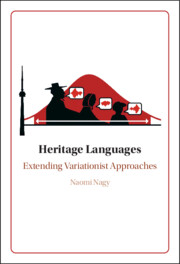Book contents
- Heritage Languages
- Heritage Languages
- Copyright page
- Epigraph
- Contents
- Figures
- Tables
- Acknowledgements
- Abbreviations
- 1 What Are Heritage Languages and Why Should We Study Them?
- 2 Experimental and Variationist Research on Heritage Languages
- 3 The Toronto Context
- 4 HLVC Methods and Tools
- 5 Cross-Variety Comparisons
- 6 Cross-Language Comparisons
- 7 Heritage Cantonese
- 8 Indexicality in Heritage Languages
- 9 Working with Heritage Languages in Linguistics Classes
- 10 What Heritage Language Speakers Tell Us about Language Variation and Change
- Bibliography
- Index
10 - What Heritage Language Speakers Tell Us about Language Variation and Change
Published online by Cambridge University Press: 09 July 2024
- Heritage Languages
- Heritage Languages
- Copyright page
- Epigraph
- Contents
- Figures
- Tables
- Acknowledgements
- Abbreviations
- 1 What Are Heritage Languages and Why Should We Study Them?
- 2 Experimental and Variationist Research on Heritage Languages
- 3 The Toronto Context
- 4 HLVC Methods and Tools
- 5 Cross-Variety Comparisons
- 6 Cross-Language Comparisons
- 7 Heritage Cantonese
- 8 Indexicality in Heritage Languages
- 9 Working with Heritage Languages in Linguistics Classes
- 10 What Heritage Language Speakers Tell Us about Language Variation and Change
- Bibliography
- Index
Summary
This chapter responds to the questions raised in Chapter 1. It reiterates the need for variationist sociolinguistic analysis of heritage languages to increase our understanding of linguistic structures, variation, and change in multilingual contexts. Each variable is considered through the lens of the profiles corresponding to different sources of change. This allows us to consider whether certain profiles are more common for certain types of variables and of language (types), and whether covariation is more prevalent among any subset of variables. We reiterate how these analyses, based on spontaneous speech in an ecologically valid environment, give a picture of heritage language speakers that contrasts with what we have learned from experimental/psycholinguistic studies, highlighting their stability and consistency with homeland varieties in most cases. Suggestions are made for how this approach can be extended to other under-documented, endangered, and smaller languages, along with discussion of benefits of the HLVC methodology to community members, educators and students, and the field of linguistics. The chapter concludes by reporting on students’ positive responses to engagement with the project.
Keywords
- Type
- Chapter
- Information
- Heritage LanguagesExtending Variationist Approaches, pp. 242 - 254Publisher: Cambridge University PressPrint publication year: 2024

